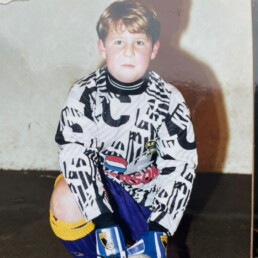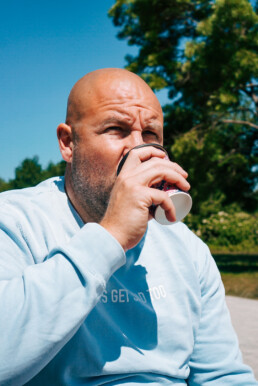How to get the most from networking
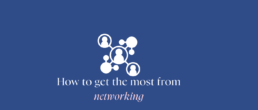
How to get the most from networking
How to Get the Most from Networking
💬 “It’s not about who you know, it’s about who knows you.” 💬
Networking can be daunting, especially in environments where personal connections seem superficial. However, building a strong network is essential for personal and professional growth.
🔍 Be genuine – Authentic connections are more valuable than a large network. Focus on building meaningful relationships rather than just collecting business cards.
👂 Listen actively – Networking isn’t just about talking about yourself. Show genuine interest in others by listening to their stories and finding common ground.
🤝 Follow up – Don’t let connections fizzle out. Follow up with new contacts to reinforce the relationship and explore potential collaborations or mutual support.
🔑 Offer value – Networking is a two-way street. Think about how you can help others in your network and offer your support and expertise where you can.
Feeling overwhelmed by networking events? Remember, it’s about quality, not quantity. Focus on a few meaningful interactions rather than trying to meet everyone.
Things to reflect on…
❓What do you want to achieve through networking?
❓How can you add value to your network?
❓What strategies have worked for you in building strong connections?
We’d love to hear your networking tips and experiences 👇
Further Reading
For more networking strategies, check out this article: The Art of Networking
How to set boundaries, and be ok with it

How to set boundaries, and be ok with it
How to Set Boundaries and Be Okay with It
💬 “Boundaries are the distance at which I can love you and me simultaneously.” 💬
Setting boundaries is crucial for maintaining healthy relationships and personal well-being. In environments where pushing limits is common, knowing how to establish and maintain boundaries can protect your mental and emotional health.
🔍 Know your limits – Understand what you’re comfortable with and what crosses the line for you. This self-awareness is the first step in setting effective boundaries.
👂 Communicate clearly – Be direct and honest when expressing your boundaries to others. Clear communication helps prevent misunderstandings and ensures your needs are respected.
🤝 Be consistent – Consistency is key in maintaining boundaries. If you set a boundary, stick to it. This helps others understand that your limits are non-negotiable.
🔑 Practice self-care – Respecting your own boundaries is just as important as getting others to respect them. Take time for yourself and engage in activities that recharge you.
Feeling guilty about setting boundaries? Remember, it’s about creating a balanced and healthy environment for yourself and those around you.
Things to reflect on…
❓What boundaries do you need to set for yourself?
❓How do you communicate your boundaries to others?
❓What challenges do you face in maintaining boundaries?
We’d love to hear your insights and challenges 👇
Further Reading
Learn more about setting boundaries with this helpful guide: How to Set Healthy Boundaries
What is authentic leadership
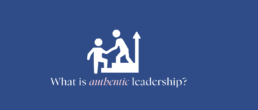
What is Authentic Leadership?
💬 “A real leader knows the way, goes the way, and shows the way.” 💬
Authentic leadership is about being true to yourself and leading with integrity. It means being honest about your strengths and weaknesses and using them to inspire and guide others. In male-dominated environments, where bravado can often overshadow authenticity, showing genuine leadership can make a significant impact.
🔍 Lead by example – Demonstrate the values and behaviors you want to see in your team. Authentic leaders walk the talk and inspire others through their actions.
👂 Be transparent – Open communication builds trust. Share your thoughts, feelings, and decisions openly with your team, and encourage them to do the same.
🤝 Embrace vulnerability – Authentic leaders aren’t afraid to show their human side. Admitting when you don’t have all the answers or when you’ve made a mistake fosters a culture of trust and continuous learning.
🔑 Foster inclusivity – Create an environment where everyone feels valued and heard. Authentic leadership thrives in diverse teams where different perspectives are respected and integrated.
Feeling unsure about your leadership style? That’s okay. Authentic leadership is a journey, not a destination.
Things to reflect on…
❓What does authentic leadership look like to you?
❓How can you practice authenticity in your daily interactions?
❓What impact does authentic leadership have on your team?
We’d love to hear your thoughts and experiences 👇
Further Reading
For more on authentic leadership, check out this insightful article: The Real Truth About Authentic Leadership
How to tackle difficult conversations in the clubhouse
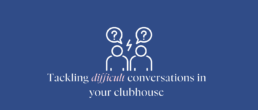
How to tackle difficult conversations in the clubhouse
Tackling Difficult Conversations in the Clubhouse
“True strength lies in vulnerability.”
Choose the Right Moment –
Timing is crucial. Find a quiet moment when you’re less likely to be interrupted.
Be Honest and Direct –
Speak from the heart and be clear about what you want to discuss. Avoid beating around the bush or sugar-coating things. Your honesty will be appreciated, even if the topic is tough.
Listen Actively –
When the other person responds, listen without interrupting. Show that you’re paying attention, maintain eye contact, and properly give them time to express their thoughts.
Stay Calm and Respectful –
Emotions can run high during difficult conversations. Keep your tone calm and respectful, even if the conversation gets heated. If either of you does get activated, suggest taking a breather and coming back when you’re more grounded. You’re each responsible for your own emotions – you’re not responsible for the other person’s. But if emotions are flaring, the dialogue won’t be productive. So take a breather and come back.
Empathise –
Listen intentionally to understand things from their perspective. It doesn’t mean you have to agree, but if you want to move things forward they *have* to feel they’ve been seen and heard. Empathy can defuse tension and foster a more open and honest dialogue. Let them know it matters to you where they’re at with this issue.
Find Common Ground –
Focus on what you both want to achieve from the conversation. Picture rather than facing off opposite each other, you’re actually beside each other, looking at a table in front of you; you each name what matters to you here and what you need from the conversation. Then you work together to find a solution where both perspectives are respected.
Finding mutual goals can help you navigate the discussion more effectively and reach a positive outcome.
Reflective Questions –
❓ How do you feel after a difficult but necessary conversation?
❓ What strategies help you stay calm and respectful during tough talks?
❓ How can you show empathy even when you disagree?
For more strategies on handling difficult conversations, read this article: How To Have Difficult Conversations Without Burning Bridges.
Public speaking - with confidence
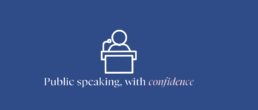
Public speaking, with confidence
Public Speaking with Confidence
“Confidence is not about being perfect. It’s about being real.”
Understand Your Fear –
Public speaking can be daunting, but recognizing why it makes you nervous is the first step. Is it fear of judgment, making mistakes, or something else? Identifying this can help you address it head-on.
Prepare Thoroughly –
Know your material inside out. This doesn’t mean memorising every word but being comfortable with the content. The more prepared you are, the more confident you’ll feel.
Visualise Success –
Before stepping up, visualise yourself speaking confidently and the audience responding positively. This mental rehearsal can boost your confidence and reduce anxiety.
Start Small –
If you’re new to public speaking, start with smaller groups. Gradually increase the size of your audience as you build confidence. Each success will make the next step easier.
Breathe and Pause –
Deep breathing can help calm your nerves. Remember, it’s okay to pause during your speech. Pauses can emphasise points and give you a moment to collect your thoughts.
Embrace Imperfection –
No one expects you to be perfect. If you stumble or forget something, it’s okay. Most of the time, the audience won’t even notice. Focus on delivering your message, not on being flawless.
Reflective Questions –
❓ What makes you most nervous about public speaking?
❓ How do you feel when you finish a successful speech?
❓ What small steps can you take to build your public speaking skills?
For more advice on public speaking, check out this insightful TED Talk: Your Body Language May Shape Who You Are.
Presenting with impact

The Speakeasy Bench
Presenting with Impact
Make Your Message Stick
“Presentation is the art of simplicity.”
Know Your Audience –
It’s essential to understand who you’re talking to. Tailor your message to their interests, knowledge level, and what they care about. Doing so will help you connect more effectively and ensure your key points hit home.
Practice Makes Perfect –
Rehearsing your presentation multiple times helps build confidence and smooth out any rough edges. Practice in front of a mirror, record yourself or ask a mate for feedback. This isn’t about memorising your speech but becoming familiar with the flow.
Engage Your Audience –
Use eye contact, and body language, and vary your tone to keep your audience engaged. Ask questions, use anecdotes, or even a bit of humour to make your presentation memorable.
Use Visuals Wisely –
Visual aids can enhance your message, but they shouldn’t be the star of the show. Use them to support your points, not distract from them. Keep slides simple and uncluttered.
Be Authentic –
Your genuine passion for the topic will shine through and resonate with your audience. Don’t be afraid to show some personality and care out loud about the area of your subject that you feel strongly about. Humans connect to humans – it makes you relatable and your message more impactful.
Reflective Questions –
❓ How does it feel when your audience is truly engaged?
❓ What techniques work best for you in capturing attention?
❓ How do you handle nerves before presenting?
For more tips on creating impactful presentations, check out this article from TED: How to Make a Great Presentation.
Trauma? I'm not dealing with any trauma. Am i?
Trauma? I'm not dealing with any trauma. Am i?
It’s National Anti Bullying week this week. Along with the stuff I’m currently talking about in therapy, it seems a very appropriate time to share a little story. Hopefully it can help other people but to be honest, it’s to help me as much as anything.
For years I’ve felt that if my son Reggie was ever in trouble for doing something wrong, no matter what it was, I would help him and be there to support him.
However, If he was being bullied or god forbid ever the bully, then I wouldn’t be able to go near the situation.
Someone else would have to get involved. The anger and fear building up inside me at the thought of needing to have that conversation with him is uncontrollable at times.
I mentioned this as an off the cuff comment in therapy not so long ago, I moved on. Very quickly my therapist intervened ” hang on a minute, tell me a bit more about that, why did you dismiss that feeling so quickly”.
Out of nowhere I said ” Now humour me here Charlotte, I doubt this has anything to do with anything, but i was quite badly bullied as a 12yr old in school, do you think that may have had any affect on me?”
”Ah” She said. ”Yes, yes I do. I think we may have found the root cause of the problems. Can you tell me a bit more about it?”.
There was this particular period halfway through year 8. A particularly lad, long story short, decided he was going to pick on me. There was never any physical bullying, but it was psychological. That was bad enough.
I was being left out of groups that I was normally involved in, isolated on the bus home from school and made to feel like in was the one doing wrong. I was being called names and left on my own. It’s f***ing awful.
One particular and very vivid time I remember being at football training one evening. I’d walked up to the car park waiting for a lift, when a good pal of mine Tom, came running up from the field and handed me my new Sheffield Wednesday jumper that I’d left behind.
The lad who was bullying me had been spitting all over it.
I know it’s just a jumper. But I loved that jumper. It meant so much to me at the time and I never wore it again after that.
I talked to Charlotte about how it felt like the bullying went on for a lifetime. In reality it was only a few weeks. That’s all it needed to be. The damage had very much been done.
My parents spoke to the lad’s mother and it was over. They were brilliant and I felt safe and supported by them the whole way. That’s all I wanted at the time. I didn’t want to interrogate things, understand why it had happened or even know what my parents had said. I just wanted it over. And it was.
With a knowing nod and (weirdly) a decent sized smile Charlotte said:
”So it turns out we’ve being doing a really good job at addressing the symptoms of why you’ve been feeling the way you’ve been feeling, however now I think we’ve found the root cause. ”
”The reason you’ve felt insecure about relationships for the last 25 years, the reason you use food, money or alcohol to try and suppress any anxiety or emotion is all linked back to this time. It’s a trauma”.
”Everything you’ve been doing is an attempt to smooth over that void you’ve had. You may not have known that’s what it was, but that’s exactly it”.
I can’t tell you the weight that was lifted when I heard that. Everything changed. For the better.
I still feel anger towards bullying, but in a different way. Friends and colleagues have said it’s very obvious when someone appears to be showing bullying tendencies, how protective I get over others, and I’ll stand up to this people but in a constructive way. That feels good.
I want to help people with similar experiences. It’s easy to ignore them and act they they didn’t have an impact.
It requires us being vulnerable, open to critics again. but out doesn’t have to be. When you’ve been in a certain situation yourself, you know how others have felt. They may never have had the opportunity to feel seen or heard before.
I want to help others to feel supported, and to move on again.
This story has a happy ending. And I really do consider it the end.
Being bullied as child doesn’t have anywhere near as much power over me as it has done for the last 25 years. I’m aware of it now and what i was doing to fight it. By facing the trauma I’ve been able to learn about it, understand the emotions that I didn’t understand, and piece together it’s connection to those negative habits.
The power is still there. But I’m in charge now.
And I’m on the hunt find that jumper again…
If you or anyone you know has been affected by bullying now or in the past, advice on how to get support can be found at the following places:
If there’s anything in this blog that you can relate to or are curious about finding out more, please don’t hesitate to reach out to me.
Take Care & Speakeasy
Simon
Be more Bison....
Be more Bison.....
”Do you know the difference between Bison & Cow’s….?”
Both can tell when a storm is coming. Bison run towards the storm, embracing the challenge and, although tired, endure the storm for less time and enjoy the lush green grass on the other side in a shorter amount of time and with less pain.
Cows wait for the storm. Then, when it arrives, they panic and run with the storm. They stay in the rain longer, enduring much, much more. All of it needlessly.
This is similar to many complex challenges we face in our lives. Unfortunately, it’s easier to run away from the problem because we’re scared and don’t understand what ‘’the next bit’’ looks like.
However, if we #BemoreBison, we can tackle the challenge head-on, embrace the immediate but short-term pain and reap the benefits on the other side much quicker.
It’s hard and scary and terrifying and uncomfortable. But in this instance, the grass is much greener on the other side. Related to personal development, 70% of our Spekaeasy Survey respondents are interested in talking therapy or 1:1 coaching.
Many people are interested in developing themselves for the betterment of their families, friends and their well-being. We’re building resources in the background to support the Speakeasy community and upskilling ourselves simultaneously.
#bemorebison
Take care & speak easy
Simon
Golf & Mental Health

Golf & Mental Health
There is so much more to golf than just hitting a ball around a field for 5 hours.
This is an honest and vulnerable conversation between two professional athletes. they share their challenges both on and off the field of play. Suicide prevention charity Campaign Against Living Miserably (CALM) is the Official Charity of the BMW PGA Championship and they took a walk with Andrew ‘Beef’ Johnston and Robbie Savage.
Ahead of this year’s tournament, Andrew ‘Beef’ Johnston and ex-footballer Robbie Savage
Click here to watch the full conversation
Always wondered why Golf is such a great thing for your Mental Health? Click this link to find out
Check out this really interesting school-based initiative from The Golf Foundation and former professional Nick Doughty. Unleash Your Drive is a comprehensive programme that can be delivered over six weeks by any teacher thanks to their easy-to-follow printed and digital resources, specially adapted Golfway kit and built-in evaluation.
Check out the below websites for resources on mental health support in golf:
‘Fore your Mental Health’ – Abergele Golf Club
Golf and Health – The R&A
The Speakeasy Survey 2023
The Speakeasy Survey 2023
WHAT IS IT ALL ABOUT?
Our survey has given us a clearer picture of how we can better support our community – by offering more learning opportunities, developing their interests and helping them stay well. We used these findings to craft actions that will make sure we’re helping them reach new heights. It’s all part of the mission to help everyone learn, connect and grow as individuals.
WHAT DID WE FIND OUT?
72% of respondents said ‘lack of time’ was a barrier to pursuing interests.
People rated personal development a 7.9/10 in terms of importance to them, and professional development was rated at 7.3/10.
77% of respondents said that their family was their top priority amongst everything.
43% of respondents said regular meet-ups were the top area of support they desired in terms of improving their wellbeing.
OUR KEY ACTIONS
Create an online & in-person community.
Make information relatable, relevant, and as easily accessible as possible.
Questions we need to ask ourselves constantly:
Do we have the person at the heart of this decision?
Will this make people’s lives easier? Happier? More enjoyable?
Will this help people challenge their thinking and support their curiosity?
Is it fun and authentic?
A one stop shop, where everything you need is inside one online community, all at the click of a button.
It’s your online clubhouse! Everything that you talk about in YOUR clubhouse is now online and easily accessible.
Wellbeing, conversations, events and more…







